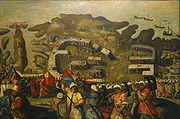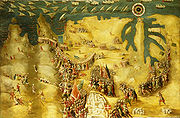
Matteo Perez d'Aleccio
Encyclopedia


Italy
Italy , officially the Italian Republic languages]] under the European Charter for Regional or Minority Languages. In each of these, Italy's official name is as follows:;;;;;;;;), is a unitary parliamentary republic in South-Central Europe. To the north it borders France, Switzerland, Austria and...
painter of devotional, historical and maritime
Sea
A sea generally refers to a large body of salt water, but the term is used in other contexts as well. Most commonly, it means a large expanse of saline water connected with an ocean, and is commonly used as a synonym for ocean...
subjects during the Mannerist
Mannerism
Mannerism is a period of European art that emerged from the later years of the Italian High Renaissance around 1520. It lasted until about 1580 in Italy, when a more Baroque style began to replace it, but Northern Mannerism continued into the early 17th century throughout much of Europe...
period. He was also known as Matteo da Lecce or Leccio by virtue of his hometown of Lecce
Lecce
Lecce is a historic city of 95,200 inhabitants in southern Italy, the capital of the province of Lecce, the second province in the region by population, as well as one of the most important cities of Puglia...
.
He studied under Michelangelo
Michelangelo
Michelangelo di Lodovico Buonarroti Simoni , commonly known as Michelangelo, was an Italian Renaissance painter, sculptor, architect, poet, and engineer who exerted an unparalleled influence on the development of Western art...
, working on the Sistine Chapel
Sistine Chapel
Sistine Chapel is the best-known chapel in the Apostolic Palace, the official residence of the Pope in Vatican City. It is famous for its architecture and its decoration that was frescoed throughout by Renaissance artists including Michelangelo, Sandro Botticelli, Pietro Perugino, Pinturicchio...
, in the Vatican
Vatican City
Vatican City , or Vatican City State, in Italian officially Stato della Città del Vaticano , which translates literally as State of the City of the Vatican, is a landlocked sovereign city-state whose territory consists of a walled enclave within the city of Rome, Italy. It has an area of...
, painting the Fall of the Angels in the facade facing Michelangelo's Last Judgment. He was a member of the Accademia di San Luca
Accademia di San Luca
The Accademia di San Luca, was founded in 1577 as an association of artists in Rome, under the directorship of Federico Zuccari, with the purpose of elevating the work of "artists", which included painters, sculptors and architects, above that of mere craftsmen. Other founders included Girolamo...
in Rome
Rome
Rome is the capital of Italy and the country's largest and most populated city and comune, with over 2.7 million residents in . The city is located in the central-western portion of the Italian Peninsula, on the Tiber River within the Lazio region of Italy.Rome's history spans two and a half...
. He also painted an altarpiece for Sant'Eligio degli Orefici.
He travelled to Naples
Naples
Naples is a city in Southern Italy, situated on the country's west coast by the Gulf of Naples. Lying between two notable volcanic regions, Mount Vesuvius and the Phlegraean Fields, it is the capital of the region of Campania and of the province of Naples...
where he met the artist Pablo Moron, who became his long standing assistant. Perez's most important works can be found in Rome. They include the fresco The Dispute over the Body of Moses (circa 1574) in the Sistine Chapel; fresco
Fresco
Fresco is any of several related mural painting types, executed on plaster on walls or ceilings. The word fresco comes from the Greek word affresca which derives from the Latin word for "fresh". Frescoes first developed in the ancient world and continued to be popular through the Renaissance...
es in the Villa d'Este
Villa d'Este
The Villa d'Este is a villa situated at Tivoli, near Rome, Italy. Listed as a UNESCO world heritage site, it is a fine example of Renaissance architecture and the Italian Renaissance garden.-History:...
in Tivoli
Tivoli, Italy
Tivoli , the classical Tibur, is an ancient Italian town in Lazio, about 30 km east-north-east of Rome, at the falls of the Aniene river where it issues from the Sabine hills...
and the Villa Mondragone
Villa Mondragone
Villa Mondragone is a patrician villa originally in the territory of the Italian commune of Frascati , now in the territory of Monte Porzio Catone...
in Frascati
Frascati
Frascati is a town and comune in the province of Rome in the Lazio region of central Italy. It is located south-east of Rome, on the Alban Hills close to the ancient city of Tusculum. Frascati is closely associated with science, being the location of several international scientific...
. He also worked in Malta
Malta
Malta , officially known as the Republic of Malta , is a Southern European country consisting of an archipelago situated in the centre of the Mediterranean, south of Sicily, east of Tunisia and north of Libya, with Gibraltar to the west and Alexandria to the east.Malta covers just over in...
(from 1576), Seville
Seville
Seville is the artistic, historic, cultural, and financial capital of southern Spain. It is the capital of the autonomous community of Andalusia and of the province of Seville. It is situated on the plain of the River Guadalquivir, with an average elevation of above sea level...
(in the 1580s) and Lima
Lima
Lima is the capital and the largest city of Peru. It is located in the valleys of the Chillón, Rímac and Lurín rivers, in the central part of the country, on a desert coast overlooking the Pacific Ocean. Together with the seaport of Callao, it forms a contiguous urban area known as the Lima...
(from 1589), where he died.
The Hall of St Michael and St George, also known as the Throne Room, of the Grandmaster's Palace, Valletta
Valletta
Valletta is the capital of Malta, colloquially known as Il-Belt in Maltese. It is located in the central-eastern portion of the island of Malta, and the historical city has a population of 6,098. The name "Valletta" is traditionally reserved for the historic walled citadel that serves as Malta's...
is decorated with 13 of his frescoes showing the events of the great siege of Malta
Siege of Malta (1565)
The Siege of Malta took place in 1565 when the Ottoman Empire invaded the island, then held by the Knights Hospitaller .The Knights, together with between 4-5,000 Maltese men,...
by the Turks
Ottoman Empire
The Ottoman EmpireIt was usually referred to as the "Ottoman Empire", the "Turkish Empire", the "Ottoman Caliphate" or more commonly "Turkey" by its contemporaries...
in 1565. He is credited with having introduced mannerism to Malta with his frescoes. These were painted from 1575 to 1581, at the same time as the oil paintings of the same scene, four of which can be found in the Cube Room of the Queen's House, Greenwich, London. Among his other works in Malta there is the Baptism of Christ which was originally the titular painting of the St. John's Co-Cathedral.
He is chiefly known for works he executed in Spain, where he had been induced to migrate in 1583. He completed a monumental fresco, in 1584, in the cathedral of Seville, representing a giant St. Christopher carrying the Infant Saviour on his shoulder. He painted in 1587 the same subject for the church of San Miguel, and he also painted in other public edifices at Seville. After residing some years in Spain, he felt his works were less valued than those of Luis de Vargas
Luis de Vargas
Luis de Vargas was a Spanish painter of the late-Renaissance period, active mainly in Seville. He traveled to Rome where he was influenced by Mannerist styles. He painted an altarpiece with multiple panels, including a Virgin and Child appearing to Adam and Eve or La Gamba for the Cathedral in...
, and returned to Rome, where he died. Others tells us that, after having acquired great riches in the West Indies, he died there in poverty.

